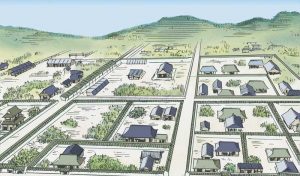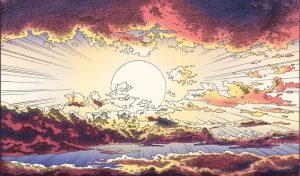The following installment is from “Nichiren: His Life and Legacy,” adapted from Ikeda Sensei’s series The World of Nichiren Daishonin’s Writings. It was originally published in November 2011 Living Buddhism, pp. 41–45.
From the Editors
Following the execution attempt at Tatsunokuchi Beach, Nichiren Daishonin. was detained under house arrest for about a month in what is now Atsugi City at the residence of Homma Rokuro Saemon, deputy constable of Sado Island.
Various disciples visited Nichiren during his time under custody. He also wrote letters of encouragement to his followers.
It was after the Tatsunokuchi Persecution that Nichiren began to inscribe the Gohonzon, the object of devotion, for his disciples.
An Ordinary Person Reveals His Identity as the Buddha of Limitless Joy
Nichiren Daishonin had vowed to dedicate his life to seeking, protecting and spreading the Mystic Law of Nam-myoho-renge-kyo. He lived entirely for the Law and made it accessible to all people. No vow could be greater.
During the 18 years from the establishment of his teaching until the Tatsunokuchi Persecution, the Daishonin waged a struggle based on the Mystic Law. It was a struggle of selfless dedication to the propagation of the Law without a moment’s rest. These efforts culminated in the Tatsunokuchi Persecution.
His life proved the greatness of a human being who has become one with the Mystic Law. The Daishonin revealed himself as the Buddha of limitless joy—the eternal Buddha who is one with the eternal Law. His inscription of the Gohonzon for the enlightenment of all living beings of the Latter Day is significant because he revealed himself as the Buddha of limitless joy while remaining an ordinary person.
Nichiren inscribed the Gohonzon and began conferring it upon some of his followers before his exile on Sado Island. He did not know when he would return. His life was threatened. For the sake of his disciples then and in the future, it was necessary to reveal a correct model for faith and practice of the Lotus Sutra in the Latter Day. Also, the Daishonin needed to establish the correct way for ordinary people to manifest the world of Buddhahood just as they are—something that he himself had achieved. This was necessary to ensure the eternal perpetuation and widespread propagation of the Law after his passing.
The Gohonzon Exists in the Lives of Ordinary People
Several of Nichiren Daishonin’s writings have an important factor in common: his emphasis that the teacher who reveals the great Law that is to be widely propagated is an ordinary person. He states that such a teacher who will lead all people of the Latter Day to enlightenment is an “ordinary practitioner” (“On Practicing the Buddha’s Teaching,” The Writings of Nichiren Daishonin, vol. 1, p. 391) and “an ordinary practitioner at the stage of hearing the name and words of the truth” (“On the Buddha’s Prophecy,” WND-1, 400).
A Buddha resplendently adorned with the 32 features and the 80 characteristics could not be the true lord of teachings in the Latter Day of the Law. The true teacher of the Latter Day is, instead, an ordinary person in every aspect, but his or her true identity is that of the Buddha. Unless the teacher is an ordinary person with the heart of the Buddha, realizing the widespread propagation of the Law in a world of ordinary people who are steeped in the three poisons of greed, anger and foolishness would be impossible.
The Buddha who manifests the inner reality of Buddhahood as an ordinary person is the true teacher of the Latter Day of the Law. Therefore, if the object of devotion were a sculpted figure of a Buddha adorned with special superhuman characteristics, this would constitute a contradiction between the teacher of the Law and the object of devotion.
The important thing is that the life of the eternal Buddha who is one with the eternal Law expresses itself in wholehearted human conduct, which includes deeds, words and thoughts. In the process of teaching the Law and overcoming great persecution, Nichiren Daishonin manifested the life of the Buddha of limitless joy—the Buddha who has been enlightened since time without beginning and is one with the eternal Law. This is the state of life inscribed on the Gohonzon.
The Inscription of the ‘Life’ of Nichiren
Nichiren Daishonin writes:
I, Nichiren, have inscribed my life in sumi ink, so believe in the Gohonzon with your whole heart. The Buddha’s will is the Lotus Sutra, but the soul of Nichiren is nothing other than Nam-myoho-renge-kyo. (“Reply to Kyo’o,” WND-1, 412)
The heart is most important. The heart means faith.
The Record of the Orally Transmitted Teachings states, “If in a single moment of life we exhaust the pains and trials of millions of kalpas, then instant after instant there will arise in us the three Buddha bodies with which we are eternally endowed” (p. 214). When we struggle for kosen-rufu, exerting a hundred million eons of effort at each moment, the immense life of the Buddha arises in our being at each moment. The three enlightened properties of wisdom, courage and compassion that we originally possess will well forth.
The Daishonin revealed the Gohonzon to teach people of this limitless life force. With the Gohonzon as a clear mirror, we should develop confidence in the existence of this power in ourselves, in our friends and in all people. To believe in the Gohonzon is to believe that all people are endowed with the life of the Buddha of limitless joy.
Nichiren writes:
Never seek this Gohonzon outside yourself. The Gohonzon exists only within the mortal flesh of us ordinary people who embrace the Lotus Sutra and chant Nam-myoho-renge-kyo. The body is the palace of the ninth consciousness, the unchanging reality that reigns over all of life’s functions. (“The Real Aspect of the Gohonzon,” WND-1, 832)
***
Abutsu-bo is therefore the treasure itself, and the treasure tower is Abutsu-bo himself. … You may think you offered gifts to the treasure tower of the Thus Come One Many Treasures, but that is not so. You offered them to yourself. You, yourself, are a Thus Come One who is originally enlightened and endowed with the three bodies. You should chant Nam-myoho-renge-kyo with this conviction. Then the place where you chant daimoku will become the dwelling place of the treasure tower. (“On the Treasure Tower,” WND-1, 299–300)
There is no other way to lead all people to enlightenment than to help them manifest the object of devotion in their own lives. The Gohonzon equally empowers all people to do just this. It opens this possibility to everyone.
The Gohonzon is the crystallization of the Daishonin’s vow for the salvation of all people; it enables all people to attain enlightenment. It is Nichiren Daishonin’s “object of devotion for observing the mind.”
The term honzon, or object of devotion, means that which is respected or revered as fundamental. The Daishonin manifested the Gohonzon as the object worthy of supreme respect that all people should take as a fundamental standard.
In praying to the Gohonzon, the awareness that it is a graphic expression of Nam-myoho-renge-kyo—the very life of Nichiren Daishonin—is key. The Daishonin manifested the supremely noble entity in his own life that is the foundation of life, the object of utmost veneration. At the same time, he recognized that the same supremely noble entity exists in the lives of all people.
Nam-myoho-renge-kyo, in addition to being the ultimate Law of the universe, is itself the supremely noble life essence that is the world of Buddhahood. It is the foundation of the supreme state of life that the Buddha has attained, which is perhaps what Nichiren means when he says he has inscribed his life.
The ultimate Law of the universe, and the life of the Thus Come One that is one with this Law, are at the core of the Buddha’s spirit and actions. This includes profound insight into and empathy with life and the resulting compassion toward all living beings, willingness to share the suffering of human beings, and actions infused with wisdom and with the aspiration to save the suffering. The Daishonin realized that this supreme law is Nam-myoho-renge-kyo.
The Daishonin reveals Nam-myoho-renge-kyo as the foundation and the essence of the Gohonzon, the fundamental object of devotion for people of the Latter Day of the Law. This is also evident in the Daishonin’s inscription of “Nam-myoho-renge-kyo Nichiren” in large characters down the center of the Gohonzon.
The Daishonin defeated the devilish functions that attacked him in the form of the three powerful enemies. At the time of the Tatsunokuchi Persecution, he attained a state of life of complete oneness with the eternal Mystic Law. It was the state of life of the Buddha of limitless joy who has been enlightened since time without beginning.
The Gohonzon: A Clear Mirror Reflecting One’s Own Life
In the writing “The Object of Devotion for Observing the Mind,” Nichiren Daishonin systematically clarifies the way for all people to reveal the object of devotion inherent in their lives. He writes, “The observation of the mind means to observe one’s own mind and to find the Ten Worlds within it” (WND-1, 356).
In other words, “observing the mind” means to perceive that our lives are originally endowed with all the Ten Worlds, from hell to Buddhahood. The true meaning of perceiving the Ten Worlds within one’s own mind lies in manifesting the world of Buddhahood within one’s own life.
Every person is fundamentally endowed with the world of Buddhahood. This truth is hard to understand and believe. Even if one may believe it at the present moment, it is easy to lapse into disbelief should something untoward happen. That is because we also possess fundamental delusion.
The Daishonin says we need a “clear mirror” to carry out the practice of observing the mind. In the Latter Day of the Law, the clear mirror is the Gohonzon.
Shakyamuni’s Lotus Sutra and T’ien-t’ai’s Great Concentration and Insight are “clear mirrors created in response to the conditions under which Buddhism was spread, including the culture, traditions and character of the people of India and China. In each era, each teaching was significant in enabling people to perceive the object of devotion in their own lives. Nichiren Daishonin inscribed the essence of these teachings in a mandala, which he left behind as a clear mirror for the people of this period of the Latter Day.
Embracing the Gohonzon and imbuing one’s own life with the world of Buddhahood through strong faith is the practice for attaining Buddhahood in the Latter Day. When we make the Buddha’s spirit for the happiness of all people our own, and take action as the Buddha’s emissary, the world of Buddhahood all the more strongly imbues our lives.
The Daishonin says: “Never seek this Gohonzon outside yourself. The Gohonzon exists only within the mortal flesh of us ordinary people who embrace the Lotus Sutra and chant Nam-myoho-renge-kyo” (“The Real Aspect of the Gohonzon,” WND-1, 832).
We must never seek the Gohonzon anywhere but within, he says. The Daishonin attained the life of the Buddha of beginningless time. His teaching would have no meaning unless we could realize the Mystic Law in our own lives and attain this supremely noble state.
When we face the clear mirror of the Gohonzon, tirelessly polishing our own lives in the midst of daily affairs, confident that we have in ourselves the same wonderful state of life as the Gohonzon embodies, our lives shine with good fortune and benefit.
In Nichiren Buddhism, “observing the mind” is another name for faith. The “object of devotion for observing the mind” is the “object of devotion of faith.” Through strong faith, we connect our lives with the object of devotion that enables all people to manifest the world of Buddhahood and perceive the Ten Worlds in their own lives. Then the Gohonzon within us is activated, and immediately we are embraced in the light of hope. Strength wells forth.
The Daishonin revealed the Gohonzon to make it possible for all people to achieve observation of the mind. The Gohonzon manifests in its entirety the great state of life of the Buddha who is our eternal mentor. When we pray to the Gohonzon, the embodiment of Nichiren’s life, and cultivate strong conviction that this Gohonzon also exists in our own lives, we dispel fundamental ignorance and manifest the life of the world of Buddhahood.
The Ceremony in the Air
Nichiren Daishonin modeled the Gohonzon after the Ceremony in the Air depicted in the “Life Span” chapter of the Lotus Sutra. The Ceremony in the Air is a symbolic expression, transcending time and space, of the eternal Law that is one with the eternal Buddha.
First, there is the image of an enormous tower soaring skyward as though to connect heaven and earth. The treasure tower of the Ceremony in the Air represents the Mystic Law, the fundamental law of the universe, as a pillar, a “central axis,” supporting the world.
The Daishonin says that Nam-myoho-renge-kyo is the heart of the essential teaching. He writes:
Shakyamuni Buddha did not transmit the five characters of Nam-myoho-renge-kyo, the heart of the essential teaching of the Lotus Sutra, even to the bodhisattvas Manjushri and Medicine King, let alone to any lesser disciples. He summoned from beneath the earth the great bodhisattvas as numerous as the dust particles of a thousand worlds and, as he preached the eight chapters, transferred it solely to them. (“The Object of Devotion for Observing the Mind,” WND-1, 366)
In the Ceremony in the Air, Shakyamuni points to the eternal Mystic Law of Nam-myoho-renge-kyo. This is the teaching for the enlightenment of all people after his passing. Through this teaching, Shakyamuni revealed the entirety of his legacy, entrusting its future propagation to his true disciples who would inherit it.
From the standpoint of his role as an incarnation of Bodhisattva Superior Practices, the leader of the Bodhisattvas of the Earth who are entrusted with this teaching, the Daishonin directly revealed Nam-myoho-renge-kyo, the fundamental Law in the depths of the “Life Span” chapter, and manifested the Gohonzon as the clear mirror that we should embrace.
If he had taught only Nam-myoho-renge-kyo without any background explanation, its true significance would have been hard to grasp. Therefore, he clarified its profound meaning by making use of the Ceremony in the Air, whose significance was already well understood.
Nichiren writes:
The true object of devotion is described as follows: The treasure tower sits in the air above the saha world that the Buddha of the essential teaching [identified as the pure and eternal land]; Myoho-renge-kyo appears in the center of the tower with the Buddhas Shakyamuni and Many Treasures seated to the right and left, and, flanking them, the four bodhisattvas, followers of Shakyamuni, led by Superior Practices. Manjushri, Maitreya, and the other bodhisattvas, who are all followers of the four bodhisattvas, are seated below. All the other major and minor bodhisattvas, whether they are disciples of the Buddha in his transient status or of the Buddhas of the other worlds, are like commoners kneeling on the ground in the presence of nobles and high-ranking court officials. The Buddhas who gathered from the other worlds in the ten directions all remain on the ground, showing that they are only temporary manifestations of the eternal Buddha and that their lands are transient, not eternal and unchanging. (“The Object of Devotion for Observing the Mind,” WND-1, 366–67)
In form, the Gohonzon depicts a multitiered structure, with the treasure tower of Nam-myoho-renge-kyo as its central axis. The Daishonin also indicates this in his writing “The Real Aspect of the Gohonzon.”
Nam-myoho-renge-kyo in the center indicates the fundamental truth. Since Nam-myoho-renge-kyo is the central axis of life and the universe, it is expressed through the treasure tower that soars up in the center of the Ceremony in the Air.
On either side are the Buddhas Shakyamuni and Many Treasures. These Buddhas indicate the functions of Myoho-renge-kyo (see “The True Aspect of All Phenomena,” WND-1, 384). Many Treasures is the Buddha of the past, signifying eternal truth. He represents the Law as the object of wisdom or that which wisdom perceives. Shakyamuni is the Buddha of the present. He represents the actual wisdom to perceive the Law. Indeed, these are the two aspects of Nam-myoho-renge-kyo.
The important point is that we make neither Shakyamuni nor Many Treasures our object of devotion. Shakyamuni and Many Treasures both became Buddhas through Nam-myoho-renge-kyo. It is always Nam-myoho-renge-kyo, the fundamental teaching for attaining Buddhahood, that we make our object of devotion.
The Expression of the Ten Worlds in One’s Life
Nichiren Daishonin perceived the Mystic Law within him and employed the Ceremony in the Air to graphically depict the cosmos of his own life. The Daishonin concludes “The Object of Devotion for Observing the Mind,” saying, “Showing profound compassion for those unable to comprehend the gem of the doctrine of three thousand realms in a single moment of life, the Buddha wrapped it within the five characters [of Myoho-renge-kyo], with which he then adorned the necks of the ignorant people of the latter age” (WND-1, 376).
Josei Toda, the second Soka Gakkai president, explained the Ceremony in the Air as follows: “The great and mystic life-state of Buddhahood is latent within our lives. The power and condition of this life state is beyond imagination, defying all description. Nevertheless, we can manifest it. This ceremony of the ‘Treasure Tower’ chapter [of the Lotus Sutra] explains that we can, for a fact, manifest the latent state of Buddhahood within our very own lives.”
Our life is a magnificent treasure tower, but it is difficult to perceive this truth. To perceive it is to “see the treasure tower,” and the “mirror” that enables us to do so is the ceremony of the “Treasure Tower” chapter.
In the latter age after the Buddha’s passing, however, the correct teaching falls into disuse and people no longer understand the symbolic meaning of the Ceremony in the Air. For this reason, making use of the ceremony in the “Treasure Tower” chapter, the Daishonin established the Gohonzon, displaying the fundamental law of Nam-myoho-renge-kyo as the “clear mirror” for perceiving the true nature of our lives.
This Gohonzon, like the treasure tower ceremony itself, makes it possible for the world of Buddhahood to become manifest in the life of each person and in the land as a whole. When we of the Latter Day of the Law, with the Gohonzon as our clear mirror, believe that this same expansive cosmos of life exists within us, we can open and reveal in our lives that vast and boundless condition. We can thereby fundamentally eliminate all suffering and build eternal, indestructible happiness.
You are reading {{ meterCount }} of {{ meterMax }} free premium articles





